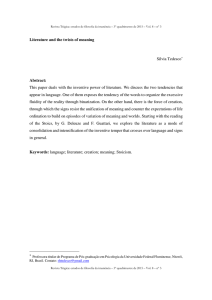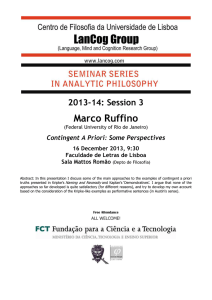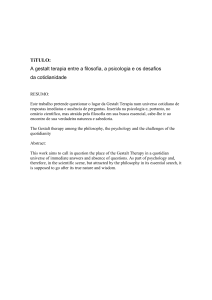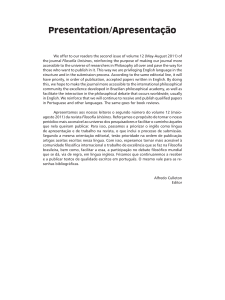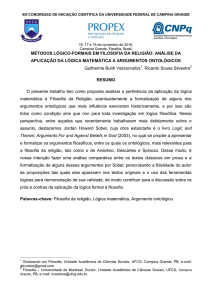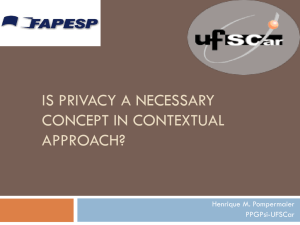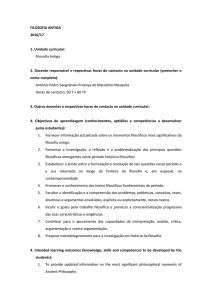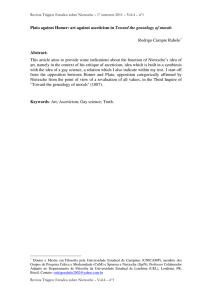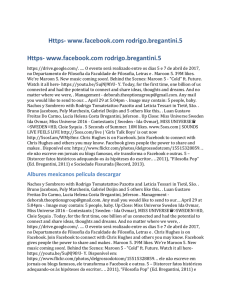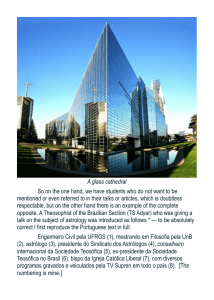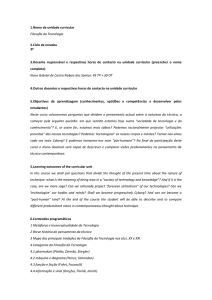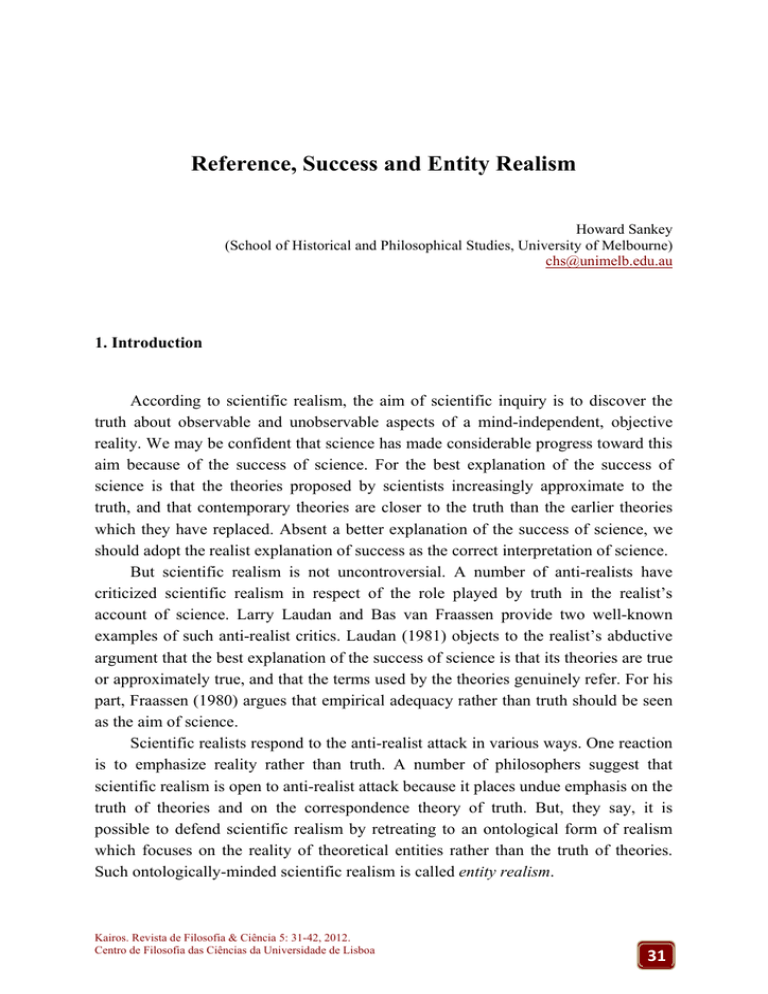
Reference, Success and Entity Realism
Howard Sankey
(School of Historical and Philosophical Studies, University of Melbourne)
[email protected]
1. Introduction
According to scientific realism, the aim of scientific inquiry is to discover the
truth about observable and unobservable aspects of a mind-independent, objective
reality. We may be confident that science has made considerable progress toward this
aim because of the success of science. For the best explanation of the success of
science is that the theories proposed by scientists increasingly approximate to the
truth, and that contemporary theories are closer to the truth than the earlier theories
which they have replaced. Absent a better explanation of the success of science, we
should adopt the realist explanation of success as the correct interpretation of science.
But scientific realism is not uncontroversial. A number of anti-realists have
criticized scientific realism in respect of the role played by truth in the realist’s
account of science. Larry Laudan and Bas van Fraassen provide two well-known
examples of such anti-realist critics. Laudan (1981) objects to the realist’s abductive
argument that the best explanation of the success of science is that its theories are true
or approximately true, and that the terms used by the theories genuinely refer. For his
part, Fraassen (1980) argues that empirical adequacy rather than truth should be seen
as the aim of science.
Scientific realists respond to the anti-realist attack in various ways. One reaction
is to emphasize reality rather than truth. A number of philosophers suggest that
scientific realism is open to anti-realist attack because it places undue emphasis on the
truth of theories and on the correspondence theory of truth. But, they say, it is
possible to defend scientific realism by retreating to an ontological form of realism
which focuses on the reality of theoretical entities rather than the truth of theories.
Such ontologically-minded scientific realism is called entity realism.
Kairos. Revista de Filosofia & Ciência 5: 31-42, 2012.
Centro de Filosofia das Ciências da Universidade de Lisboa
31 Howard Sankey In this paper, I will discuss the version of entity realism presented by Ian
Hacking in his book, Representing and Intervening (1983), and summarized in his
paper ‘Experimentation and Scientific Realism’ (1984). Hacking thinks that an
ontological form of scientific realism may be defended by focussing on experimental
practice which involves the manipulation of unobservable entities. I have much
sympathy for the position developed by Hacking, especially the pragmatist orientation
of his approach to realism. Nevertheless, I point to two issues that reflect negatively
on Hacking’s version of the entity realist position.1
2. Hacking’s Representing and Intervening
Ian Hacking thinks that philosophers of science have placed too much stress on
scientific theories and the question of whether theories represent reality. Too little
attention has been paid to practice and the way scientists intervene in reality. That is
the central theme of his book, Representing and Intervening (1983).
Hacking thinks that philosophers’ preoccupation with linguistic and theoretical
representation of reality is excessive. The preoccupation generates undue concern
with questions about the nature of reference and correspondence truth. Such an
emphasis on issues of representation leaves the way open for anti-realist critique of
the notions of reference and truth, as well as of the epistemological basis for belief in
the truth of theories and the reference of theoretical terms.
Philosophical concern with representation suggests a spectator theory of
knowledge, which the pragmatist John Dewey thought characteristic of traditional
epistemology (1983, pp. 62 ff). According to the spectator theory of knowledge, the
objects of knowledge exist “out there” in the external world. The knower is a
spectator who observes them. The objects of knowledge are distinct from the knower,
whose thoughts and concepts and words reflect or represent or correspond to reality.
By contrast, the pragmatist emphasizes that human knowers are not just
spectators viewing reality. They are also agents or actors actively engaged with the
world, where they have to act. Hacking follows John Dewey’s pragmatist rejection of
the spectator theory. His advice is to “think about practice, not about theory” (1983, p.
274). In particular, Hacking says, look at how scientists work in the laboratory. Look
at their action, and what they do. Notice how scientists intervene in reality in the
1. The restriction to Hacking’s version of entity realism is important. Clarke (2001) shows that
Hacking’s experimental argument for realism differs from that employed by Cartwright in
support of her version of entity realism. Some of the points made in this paper may not apply to
other versions of entity realism such as Cartwright’s.
32 Kairos. Revista de Filosofia & Ciência 5: 2012.
Centro de Filosofia das Ciências da Universidade de Lisboa
Reference, Success and Entity Realism
course of laboratory work, how they cause things to happen, produce effects, “create
phenomena” (1983, p. 220).
Hacking seeks to rescue scientific realism from anti-realist attack by placing it in
a pragmatist setting. Here are two passages from Representing and Intervening, which
illustrate this:
Most of today’s debate about scientific realism is couched in terms of theory,
representation, and truth. The discussions are illuminating but not decisive. This is
partly because they are so infected with intractable metaphysics. I suspect there can
be no final argument for or against realism at the level of representation. When we
turn from representation to intervention, to spraying niobium balls with positrons,
anti-realism has less of a grip. (1983, p. 31)
To attempt to argue for scientific realism at the level of theory, testing, explanation,
predictive success, convergence of theories, and so forth is to be locked into a world
of representations. No wonder that scientific anti-realism is so permanently in the
race. It is a variant on the ‘spectator theory of knowledge’. (1983, pp. 273-4)
Hacking’s idea is that the representational approach lets anti-realism in the door.
To focus on practice as the grounding for scientific realism leaves anti-realism with
less room to manoeuver.
3. Entity realism vs. theory realism
Hacking distinguishes between two forms of scientific realism, which he calls
theory realism and entity realism (1983, p. 29). Theory realism emphasizes issues of
representation and is open to anti-realistic attack. Entity realism emphasizes the
reality of unobservable entities and can be grounded in experimental practice.
Entity realism is a minimal form of scientific realism. Hacking describes entity
realism as the thesis that “a good many theoretical entities exist” (1983, p. 27). Entity
realism does not say that scientific theories are true. It says simply that certain entities
posited by scientific theories really exist.
Because entity realism asserts that we may have a basis to believe in the
existence of particular theoretical entities, it contrasts directly with two forms of antirealism. The instrumentalist denies that unobservable theoretical entities really exist.
Theoretical entities are theoretical fictions, useful in making predictions. By contrast,
constructive empiricism holds that, while unobservable entities may exist, we cannot
know that any given theoretical entity is real. So we must reserve judgment about
their existence, and not accept entity realism.
Kairos. Revista de Filosofia & Ciência 5: 2012.
Centro de Filosofia das Ciências da Universidade de Lisboa
33 Howard Sankey Entity realism also contrasts with theory realism. The main theses of theory
realism involve the truth of theories. Theory realism holds that science aims at the
truth. Toward this end, science aims to produce true theories. It also says that
“scientific theories are either true or false independent of what we know” (1983, p.
27). That is, whether our theories are true or not is determined by the way the world
is, rather than by our thinking that they are true or false.
4. Are entity realism and theory realism distinct?
One might object that there is no genuine distinction between entity and theory
realism. On the one hand, if a theory says that an entity exists, and that entity really
does exist, then what the theory says is true. On the other hand, if a theory says
something true about an entity, then the entity must exist. So, surely entity realism
and theory realism come to the same thing.
Hacking argues that this is not the case on two grounds.
On the one hand, theoretical terms may be interpreted as not referring to real
entities. They may be understood as complex logical constructions which refer only
to observable properties or things.
It might seem that if you believe a theory is true, then you automatically believe that
the entities of the theory exist. For what is it to think that a theory about quarks is
true, and yet deny that there are any quarks? Long ago Bertrand Russell showed
how to do that. He was not, then, troubled by the truth of theories, but was worried
about unobservable entities. He thought we should use logic to rewrite the theory so
that the supposed entities turn out to be logical constructions. The term ‘quark’
would not denote quarks, but would be shorthand, via logic, for a complex
expression which makes reference only to observed phenomena. Russell was then a
realist about theories but an anti-realist about entities. (1983, p. 27)
That is, a theory which is interpreted so that its apparent reference to theoretical
entities is construed as reference to observables could still come out true, provided its
observable consequences were true. If this is right, a theory might be true though it
refers to no unobservable entities. One could then be a theory realist but not an entity
realist.
On the other hand, Hacking argues that one may be a realist about entities
without being a realist about theory. Hacking says that we may:
... have good reason to suppose that electrons exist, although no full-fledged
description of electrons has any likelihood of being true. Our theories are constantly
revised; for different purposes we use different and incompatible models of
34 Kairos. Revista de Filosofia & Ciência 5: 2012.
Centro de Filosofia das Ciências da Universidade de Lisboa
Reference, Success and Entity Realism
electrons which one does not think are literally true, but there are electrons,
nonetheless. (1983, p. 27)
According to Hacking it is perfectly possible to believe in electrons without
believing in any particular theory about electrons. In fact, one could reject all electron
theories as false and still accept the existence of electrons. Given this, an entity realist
need not be a theory realist.
5. Musgrave’s hobgoblin objection
Hacking’s idea that one might believe in a theoretical entity, such as electrons,
but in no theory about electrons is open to objection.
Alan Musgrave is critical of entity realism on these grounds:
We are to believe in scientific entities (believe that theoretical terms refer), without
thinking true any theory about those entities. We are to be ‘entity-realists’ without
being ‘theory-realists’ ... This is incoherent. To believe in an entity, while believing
nothing further about that entity, is to believe nothing. I tell you that I believe in
hobgoblins (believe that the term ‘hobgoblin’ is a referring term). So, you reply, you
think there are little people who creep into houses at night and do the housework.
Oh no, say I, I do not believe that hobgoblins do that. Actually, I have no beliefs at
all about what hobgoblins do or what they are like. I just believe in them.
(Musgrave, 1996, p. 20)
In other words, Musgrave argues, it makes no sense to say that you believe in
something but that you do not believe anything at all about it. So it is impossible to be
an entity realist who believes in electrons but believes nothing about them.
However, Hacking does not hold that belief in a theoretical entity involves no
knowledge or belief about the entity whatsoever. He says that there is:
... a family of causal properties in terms of which gifted experimenters describe and
deploy electrons in order to investigate something else, for example weak neutral
currents and neutral bosons. We know an enormous amount about the behaviour of
electrons. (1983, p. 272)
Hacking’s view is that belief in electrons involves a certain amount of detailed
knowledge of how electrons behave. But such belief need not involve belief in the
truth of any particular theory about the nature of electrons. In other words, one may
believe in electrons, and believe a number of things about electrons, without believing
in any particular theory of electrons.
Kairos. Revista de Filosofia & Ciência 5: 2012.
Centro de Filosofia das Ciências da Universidade de Lisboa
35 Howard Sankey 6. Entity realism and the causal theory of reference
The problem raised by Musgrave leads to a question about the reference of
theoretical terms, which must be faced by the entity realist.
Musgrave asks how one may believe in hobgoblins without believing anything
about them. It makes no sense to say that one believes in hobgoblins but one does not
have any beliefs about them. One must have some beliefs about hobgoblins – e.g., that
they are small creatures that come out at night and clean the dishes – in order for
one’s belief to be a belief about hobgoblins. For without believing that hobgoblins
possess some identifying characteristics, there is no way to distinguish them from
anything else. In which case, there is no way to individuate a thing as a hobgoblin,
rather than another thing.
The question of whether one must have some beliefs about the way hobgoblins
are in order to even have a belief about hobgoblins leads to the issue of reference. The
question of what is required in order to have a belief about a thing is a question about
what is required in order to refer to something. To frame the discussion, we may
distinguish between the two major approaches which have been taken to the question
of reference.
On the one hand, the traditional approach of Frege and Russell is the so-called
description theory of reference. According to the description theory of reference,
reference is determined by a description that is associated with a term. A term refers
to the set of things that satisfies the description associated with the term. For example,
to refer to electrons, a correct description of electrons must be employed. The term
‘electron’ refers to electrons because the description is true of them.
On the other hand, a more recent approach due to Kripke and Putnam is known
as the causal theory of reference. According to the causal theory, reference is fixed at
the introduction of a term by causal relations into which speakers enter with objects in
their environment. This account is most readily applicable to the ostensive
introduction of names for particular objects. But it may be extended to theoretical
terms that refer to unobservable entities. Thus, the term ‘electron’ refers to the entities
responsible for observed electrical phenomena, where the phenomena may be
specified by ostensive means. Introduction of a theoretical term may require use of a
minimal description, such as ‘the cause of that phenomenon’, where the phenomenon
is specified by ostension. But the reference is fixed by the causal relation between
language user and observed phenomenon, combined with the causal relation between
the phenomenon and its underlying cause. Presumably the causal relations may
36 Kairos. Revista de Filosofia & Ciência 5: 2012.
Centro de Filosofia das Ciências da Universidade de Lisboa
Reference, Success and Entity Realism
include the sort of experimental manipulation of entities to which Hacking draws
attention in his discussion of laboratory practice.
Because the description theory requires that a description be true of the entities
to which a term refers, the description theory fits well with theory realism. If, as the
theory realist suggests, theories are to be regarded as purportedly true descriptions of
their domains, then it is no great step to likewise suppose that reference is secured to
the entities in a theory’s domain by means of the descriptions that the theory provides
of those entities. By contrast, the causal theory allows that reference may be
determined in a non-descriptive manner. Hence, it does not require that a theory
provide a true description of theoretical entities in order to secure reference to them.
Given this, the causal theory seems well-suited for entity realism.
At least, this appears to be Hacking’s view of the matter.2 Hacking appeals to the
causal theory of reference in his development of entity realism. He calls it a
‘referential model of meaning’.3
It was once the accepted wisdom that a word such as ‘electron’ gets its meaning
from its place in a network of sentences that state theoretical laws. Hence arose the
infamous problems of incommensurability and theory change ... Putnam saved us
from such questions by inventing a referential model of meaning ... J.J. Thomson,
H.A. Lorentz, Bohr and Millikan were, with their different theories and
observations, speculating about the same kind of thing, the electron ... The
stereotype of the electron has regularly changed, and we have at least two largely
incompatible stereotypes, the electron as cloud and the electron as particle ...
Johnstone Stoney, Lorentz, Bohr, Thomson and Goudsmit were all finding out more
about the same kind of thing, the electron. (1984, pp. 157-8)
Thus, a further component of Hacking’s response to Musgrave’s hobgoblin
objection is simply that reference may indeed be secured independently of theory,
since, as the causal theory shows, reference need not be determined by description.
Of course, this is not unproblematic. As is well known, the causal theory must
be modified to allow a significant role for description in order to deal with the
problem of the reference of theoretical terms.4 This point is most easily illustrated by
2. See Resnik (1994, pp. 398-400) for a similar point.
3. The fact that Hacking describe the causal theory as the ‘referential model of meaning’
reflects the fact that a theory of reference may also be understood as a theory of meaning.
Indeed, both the description theory and the causal theory may be understood as theories of
meaning as well as reference. However, for present purposes, it is only necessary to consider
them as theories of reference. This is because the question of present interest is whether the
reference of the terms employed by scientific theories may be fixed by description or by causal
relationship between speaker and referent.
4. For detailed discussion of the issue, see Sankey (1994, ch. 2). Apart from the problem of the
reference of theoretical terms, there is another more basic problem, the so-called qua problem.
As Devitt and Sterelny (1987) note, categorial expressions are required in order to specify
Kairos. Revista de Filosofia & Ciência 5: 2012.
Centro de Filosofia das Ciências da Universidade de Lisboa
37 Howard Sankey considering the failure of reference of such terms. If a theoretical term is introduced
in order to refer to the unobservable cause of some observable phenomenon, then it
cannot fail to refer, given that the observable phenomenon exists. But theoretical
terms that have been introduced in the history of science have sometimes failed to
refer (e.g. ‘phlogiston’). To allow for the failure of reference of theoretical terms,
some descriptive apparatus must be employed in conjunction with causal relations in
order to fix the reference of theoretical terms. It is only if this supplementary
reference-fixing description fails to be satisfied that the theoretical term may fail to
refer. The modified causal theory of reference that results from granting an enhanced
role to description is usually known as a causal descriptive theory of reference.5
In light of the need to grant a role to description in reference-fixing, the use
made by Hacking’s entity realism of the causal account of reference is open to
criticism. The need to incorporate a role for description places pressure on the entity
realist to abandon a pure causal account of reference in favour of a causal descriptive
approach, thereby drawing the entity realist closer to theory realism. Conversely, to
the extent that entity realism is committed to a pure causal account of reference, the
problem of the reference of theoretical terms provides a basis to prefer a position
closer to theory realism than the entity realist alternative.
7. The experimental argument for scientific entity realism
Hacking claims that there is an argument based on considerations about
experimental practice that provides strong support for entity realism. Since entity
realism does not involve assumptions about the truth and reference of theories it may
resist anti-realist attacks such as van Fraassen’s and Laudan’s, which raise problems
about the truth of theories. Thus, Hacking’s argument for entity realism is meant to
support a form of realism which is resistant to anti-realist attack.
Hacking’s central claim is that it is what scientists do with theoretical entities
that establishes their reality. He mentions an experiment which studies free quarks
that a scientist-friend told him about. In the experiment, a niobium droplet weighing
reference at the introduction of a term. The problem is most clearly illustrated in the case of the
ostensive introduction of a natural kind term in the presence of a sample of an observable
natural kind. Ostension alone (i.e. mere pointing) is unable to specify the kind to which the
sample belongs. The use of ostension at the introduction of a term must be supplemented by the
use of categorial term that specifies the kind to which the sample belongs (Devitt and Sterelny
1987, p. 73). Similar remarks apply to the ostensive introduction of names for particular objects
(Devitt and Sterelny 1987, p. 65).
5. For discussion, see Devitt and Sterelny (1987), as well as Sankey (1994).
38 Kairos. Revista de Filosofia & Ciência 5: 2012.
Centro de Filosofia das Ciências da Universidade de Lisboa
Reference, Success and Entity Realism
less than 10-4 grams has an electric charge placed on it. The charge on the droplet is
gradually altered. If it changes in a particular way, that is a sign that a free quark is
present.
Hacking says,
Now how does one alter the charge on the niobium ball? “Well, at that stage,” said
my friend, “we spray it with positrons to increase the charge or with electrons to
decrease the charge.” From that day forth I’ve been a scientific realist. So far as I’m
concerned, if you can spray them then they are real. (1983, p. 23)
Hacking’s point is not that the experiment proves the existence of quarks.
Rather, it proves the reality of electrons and positrons!
If you can routinely build instruments which emit streams of electrons and
positrons, in order to produce knowledge about other things, then electrons and
positrons have got to exist. In short, given such practice, we should be realists about
electrons and positrons.
According to Hacking, what can be done by means of unobservable entities
within the context of experimental practice supports entity realism.
Experimental work provides the strongest evidence for scientific realism. This is not
because we test hypotheses about entities. It is because entities that in principle
cannot be ‘observed’ are regularly manipulated to produce a [sic] new phenomena
and to investigate other aspects of nature. They are tools, instruments not for
thinking but for doing. (1983, p. 262)
Here Hacking’s pragmatism is evident in his emphasis on practical activity, and
his grounding of entity realism in such practice. When scientists can do things with
unobservable entities in experimental practice, their incorporation into practice
establishes their reality.
He claims, further, that:
The more we come to understand some of the causal powers of electrons, the more
we can build devices that achieve well-understood effects in other parts of nature.
By the time that we can use the electron to manipulate other parts of nature in a
systematic way, the electron has ceased to be something hypothetical, something
inferred. It has ceased to be theoretical and has become experimental. (1983, p. 262)
In short, being able to systematically manipulate unobservable entities to
intervene in nature makes such entities experimental rather than merely theoretical or
hypothetical entities. Experimental entities are real, which supports entity realism.
Kairos. Revista de Filosofia & Ciência 5: 2012.
Centro de Filosofia das Ciências da Universidade de Lisboa
39 Howard Sankey 8. Hacking’s argument
What is Hacking’s argument from experimental practice to accepting the reality
of such experimentally manipulable but unobservable entities? How does he propose
to support entity realism on the basis of such practice?
The standard argument for scientific realism is the success argument. According
to the success argument, the best explanation of the success of science is that the
terms of mature scientific theories refer and that such theories are true, or at least
close to it. On Hacking’s analysis, the success argument is designed to support theory
realism. This is because it focuses on reference and truth. Given the latter, it is open
to the sort of anti-realist objections due to Laudan and van Fraassen, which were
briefly mentioned at the start of this paper.
In contrast with the success argument, Hacking calls the argument for entity
realism based on experimental practice the experimental argument for realism. He
insists that it differs from the success argument.
The argument ... is not that we infer the reality of electrons from our success. We do
not make the instruments and then infer the reality of the electrons... (1983, p. 265).
The instruments which emit electrons are not treated as hypotheses which are
accepted because they have passed tests. And it is not accepted that the instruments
really do emit electrons because emission of electrons best explains the successful use
of such instrumentation. Rather, Hacking says,
We are completely convinced of the reality of electrons when we regularly set out to
build – and often enough succeed in building – new kinds of device that use various
well-understood causal properties of electrons to interfere in other more
hypothetical parts of nature. (1983, p. 265)
Once upon a time the best reason for thinking that there are electrons might have
been success in explanation ... [but] ability to explain carries little warrant of truth ...
Luckily we no longer have to pretend to infer from explanatory success ...
[Scientists] don’t explain phenomena with electrons. They know how to use them.
(1983, pp. 272-2)
Anti-realism about atoms was very sensible ... a century ago. Anti-realism about any
submicroscopic entities was a sound doctrine in those days. Things are different
now. The ‘direct proof’ of electrons and the like is our ability to manipulate them
using well-understood low-level causal properties.(1983, p. 274)
In these passages, Hacking suggests that the experimental argument for realism
is not an inference to the best explanation of the success of science. Rather, we are
convinced of the reality of electrons before we build instruments which use them. We
40 Kairos. Revista de Filosofia & Ciência 5: 2012.
Centro de Filosofia das Ciências da Universidade de Lisboa
Reference, Success and Entity Realism
do not infer the reality of electrons from the success of explanations that refer to
electrons. We do not infer electrons because we use and manipulate electrons. It is a
mistake to speak of inference because the reality of electrons is directly proven by the
fact that we employ them to intervene in other things. Our practical activity which
uses electrons to spray them at other things shows that they are real.
9. Is this a success argument?
As appealing as Hacking’s appeal to practice may be, the claim that it is not an
argument to the best explanation fails to be persuasive. The point is elaborated at
length by David Resnik in his detailed discussion of the experimental argument
(Resnik, 1994).
Hacking’s argument is in fact an inference to the best explanation of successful
experimental practice. It proceeds roughly as follows. Scientists think that they
employ some instruments to emit streams of electrons. The experiments that they
conduct using these instruments are successful. The best explanation of the success of
these experiments is that there really are electrons, and that electrons really are
emitted by the instruments. Otherwise, it would be very difficult to explain why the
experiments and instruments work so well. If electrons were not real entities, then it
would be extremely difficult to explain why experimental practice based on such
instrumentation works as well as it does.
This argument for entity realism is an argument from the success of routine
experimental practice to the existence of entities. It is, therefore, an argument for
entity realism from the best explanation of a certain form of scientific success. So
Hacking is wrong to present it as differing from the standard success argument for
realism.
It is true that the argument is an argument for entity realism rather than for
theory realism. So it may enable realism to escape some anti-realist attacks. But it is
still an argument for realism based on the claim that realism is the best explanation of
the success of science.
10. Conclusion
Where, then, do things stand with Hacking’s entity realism? In this paper, I
have highlighted two issues that seem to me to militate against Hacking’s version of
Kairos. Revista de Filosofia & Ciência 5: 2012.
Centro de Filosofia das Ciências da Universidade de Lisboa
41 Howard Sankey entity realism. First is the issue of the reference of theoretical terms. Hacking’s entity
realism seems to assume that the reference of theoretical terms may be fixed without
any descriptive apparatus. But this seems implausible: the need for at least some
descriptive content leads away from an entity realism in its purest form. Second is the
issue of the experimental argument itself. Hacking insists that the experimental
argument is not a success argument, and so avoids the pitfalls of the success
argument. But, as we have seen, the experimental argument is a success argument
applied to the success of experimental science. Any reservations we might have about
the success argument are of clear relevance to the experimental argument for entity
realism.
References
Clarke, Steve (2001), ‘Defensible Territory for Entity Realism’, The British Journal for the
Philosophy of Science 52: 4, pp. 701-722.
Devitt, Michael and Kim Sterelny (1987), Language and Reality: An Introduction to the
Philosophy of Language, Blackwell, Oxford.
Hacking, Ian (1983), Representing and Intervening, Cambridge University Press,
Cambridge.
Hacking, Ian (1984), ‘Experimentation and Scientific Realism’, in J. Leplin (ed.), Scientific
Realism, University of California Press, Berkeley, Calif., pp. 154-172.
Laudan, Larry (1981), ‘A Confutation of Convergent Realism’, Philosophy of Science 48,
19-49.
Musgrave, Alan (1996), ‘Realism, Truth and Objectivity’, in R.S. Cohen, R. Hilpinen and
Q. Renzong (eds.), Realism and Anti-Realism in the Philosophy of Science, Kluwer Academic
Publishers, Dordrecht, pp. 19-44.
Resnik, David (1994), ‘Hacking’s Experimental Realism’, Canadian Journal of Philosophy
24, 395-412.
Sankey, Howard (1994), The Incommensurability Thesis, Avebury, Aldershot
Van Fraassen, Bas (1980), The Scientific Image, Oxford University Press, Oxford.
42 Kairos. Revista de Filosofia & Ciência 5: 2012.
Centro de Filosofia das Ciências da Universidade de Lisboa

